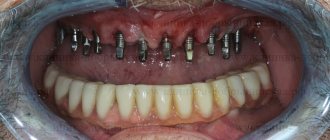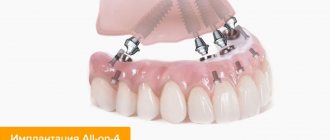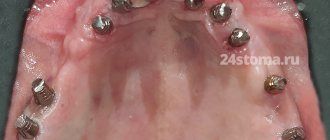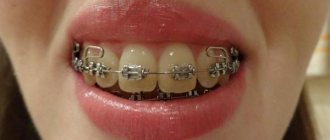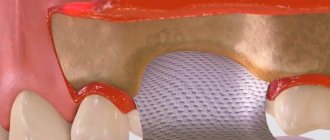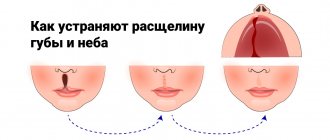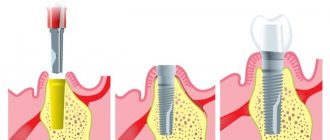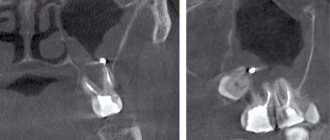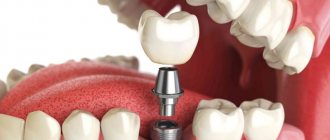For effective and high-quality orthopedic and orthodontic treatment for malocclusions of various etiologies, the use of special additional devices is often required. One of them is the facebow, which has two purposes: orthopedic and orthodontic.
An orthopedic face bow is a mechanical device that serves to develop the correct trajectory of jaw movement; it is also used to create a working model of the jaw and transfer it to three-dimensional space. The use of an orthopedic facebow is an integral part of high-quality prosthetics.
An orthodontic facebow is used as an additional structure when correcting malocclusions and is often combined with other orthodontic appliances.
Use of a facebow in orthopedics
The use of a facebow in orthopedics minimizes all inaccuracies and errors in the manufacture of prostheses.
According to the principle of operation, the face arc is divided into types:
Standard (medium anatomical) - consists of a U-shaped metal plate, which is fixed on the head using an ear or nose pad, and a bite fork, which is attached to the teeth (base wax is applied to it for an impression). The standard type of arch is applied to edentulous jaws for the manufacture of removable dentures.
Kinematic - such an arch is fixed at the point of the chin and the middle of the forehead line, allows you to get very accurate results, copies the correct position of the axis when moving the jaw, and is used in the manufacture of partial elastic dentures.
For greater efficiency, an articulator is also used, which allows you to reproduce the natural movement of the lower jaw.
Advantages of using the device
The positive qualities of a facebow in dentistry are as follows:
- eliminating errors when modeling a bite on a prosthesis: previously, dental technicians received from the dentist only impressions of the jaws and a detailed description of the bite - and it was not always possible to create ideal dentures based only on these data,
- acceleration of prosthetics: since the patient does not need to come for frequent fittings, after which the prosthesis is sent for revision,
- manufacturing a comfortable, aesthetic and functional design,
- faster adaptation and restoration of diction after prosthetics,
- the chewing load is distributed more evenly along the row,
- extending the period of use of the prosthesis: because it is made in full accordance with the patient’s bite relationships, which reduces the risk of breakages - cracks, chipping or abrasion of artificial teeth,
- the smile looks harmonious: the teeth are aligned relative to the facial features (bridge of the nose, nose, chin).
Don't know what type of prosthetics to choose?
We will help in the selection, advise where to read more information and compare types of prosthetics.
Consultation with an orthopedic doctor in Moscow clinics is free! Call now or request a call
Working hours: from 9:00 to 21:00 - seven days a week
Advantages
The use of an orthopedic facebow has a number of advantages:
- Installation of dentures is faster and the time spent visiting the dentist's office is reduced.
- The manufactured design is characterized by a high degree of wearing comfort.
- Thanks to the precise anatomical shape of the structure, the period of adaptation to it is reduced.
- Thanks to taking into account anatomical features in the manufacture of the prosthesis, chewing function is restored quickly and comfortably.
- The load on the teeth is correctly distributed, which increases the life of the prosthesis, as well as supporting teeth or implants.
- Good cosmetic effect and high aesthetics.
How much does the examination cost?
The cost of taking bite parameters using a facebow is difficult to separate from the total price of prosthetics, because it is not usually considered separately. After all, not only this, but also other devices are used for prosthetics: myographs, axiographs, articulators, etc. It is also necessary to take impressions - classical or digital - and take photographs of the face and X-rays. Without this, it is simply impossible to simulate an ideal smile and get a prosthesis that will feel like your own teeth in your mouth. If we take into account a comprehensive examination and registration of all parameters before prosthetics, then its cost can be 3000 rubles and 30 thousand - depending on the volume of the clinic’s capacities involved.
Application of a facebow in orthodontics
The orthodontic use of a facebow is aimed at eliminating pathologies of the jaw structure and lack of space in the dentition.
The device is a curved arc consisting of two parts:
- Intraoral – the inner part of the arch is attached to support rings that are fixed to the teeth.
- Extraoral – fastening elements are fixed to an elastic bandage, which is fixed on the patient’s head or neck.
The following types of fixation exist:
- Fastening on the head – used to correct anomalies of the upper jaw, the bandage is fixed on the back of the head.
- Design with fixation on the neck – involves the elimination of defects of the lower jaw.
- Combined fixation – involves the simultaneous use of the head and neck, used for severe pathology of the dentofacial apparatus.
How to work with the structure
How to use a facebow? Installation or application is carried out in three ways. The first two overlay algorithms are used for average anatomical devices, the third – for kinematic ones. Let's consider them further.
The first method of installing a mid-anatomical device
The generally accepted steps for installing a mid-anatomical facebow are as follows:
- The bite fork is tried on the upper row of teeth and removed,
- The bite fork with the applied impression material is easily pressed against the upper teeth or toothless gums: the fork is held from below with fingers or cotton rolls,
- the device is fixed at several points using stops: in the external auditory canals, as well as a nasal stop on the bridge of the nose,
- the fork is attached to the main frame using a three-dimensional clamp,
- the device is adjusted and records the position of the upper jaw and the axis of rotation of the lower jaw,
- the fork is removed from the facebow along with the mount and transferred to the plaster table and then to the articulator. After that, a plaster model of the upper jaw is worked out in the articulator, taking into account the parameters obtained when applying the arch.
It is important that for high-quality reading of parameters, the patient must be relaxed and his shoulders should not be tense. Some devices are more convenient to install when the patient is in a lying position, and registration occurs in a sitting position.
“When I went to get prosthetic teeth, I thought that impressions would be taken and that would be it. They also took facial parameters with a special device to make the prosthesis better. This is a frame that is attached to the ears, and a small spatula for impressions is attached to the teeth. Then you hold the frame yourself on the sides, and the prosthetist stands opposite and tells you which hand to raise so that the alignment matches.”
Svetlana Sh., review from the website stomatology.rf
The second method of installing a mid-anatomical device
The second technique, in general, repeats the first, but with one difference. The device is attached here using joint supports (not ear rests). That is, not to the ears, but next to them on the face - approximately at the center of rotation of the TMJ condyle. In this case, the measurement error is about 2 mm.
The third method is for a kinematic arc
When using a kinematic device, the fork is initially attached not to the upper, but to the lower jaw. Next, the patient begins to move his jaw in different directions - back, forward, closing and opening his mouth. At this time, the joint stops begin to move, and the dentist marks the resulting points - these are the central positions of the heads in the joints. After this, the fork is transferred to the upper jaw and the parameters are continued to be taken using the first method (described above).
Advantages and disadvantages
The facebow in orthodontics is an effective tool in eliminating many anomalies in the development of occlusion.
The indisputable advantages of the face bow are:
- Relatively short treatment period (up to 6 months).
- Low cost due to the simplicity of the device and materials used.
- The ability to use the device at night without causing psychological discomfort (the design cannot be seen by strangers).
- High efficiency of the device, even in the most severe cases.
The disadvantages include the bulkiness of the design and fragile fixation, as a result of which the fastening element can jump off the support rings and injure the mucous membrane.
Indications and contraindications for installation
The decision to install a facebow is made by the orthodontist. Treatment with an orthodontic device is prescribed to patients:
- with an incorrect bite
- abnormalities of jaw development,
- displacement of dental units,
- crowded teeth.
A facebow is most effective in correcting malocclusions in children under 14 years of age while the skull bones continue to develop.
There are contraindications to wearing a metal structure:
- metal allergy,
- psychoneurological disorders,
- missing several teeth,
- inflammation of periodontal tissues,
- acute diseases of the oral cavity,
- arthrosis of the jaw joints.
If there are restrictions, doctors select other correction methods.
What you need to know when using a facebow
For high effectiveness of using the design, a patient who is prescribed a face bow should follow a number of recommendations. They consist of observing the following rules:
- Daily use of the device should not exceed ten hours.
- To eliminate pain and discomfort that may occur when moving teeth into the correct position, it is recommended to use painkillers,
- Before fixing the arch, it is necessary to carry out high-quality hygienic treatment of the structure and the oral cavity.
- The facebow should only be worn when at rest.
- During the period of use of the arc, the gums may become inflamed. In this case, to eliminate the causes of swelling and redness of the gums due to excessive pressure of the arc on the tissue, it is necessary to visit a dentist,
- If you use the arc while sleeping, you need to make sure that it is securely fastened.
Despite the bulkiness of the design, the face bow, when used correctly, is an effective orthodontic device.
General overview
Orthodontic treatment is not only about braces and corrective plates. The list of technologies used is wider - some of them appeared relatively recently, while other methods have been repeatedly tested in practice, demonstrating their effectiveness. A facebow in orthodontics is a device whose task is to align the position of teeth. Such designs, as a rule, are made of a special metal that is characterized by hypoallergenic properties and does not pose a threat to the human body.
The appointment of an arch is a rather rare practice for domestic orthodontics. This technique allows you to eliminate malocclusions of a high degree of complexity, correcting the dentition and restoring the natural structure of the jaw. The system is often combined with braces, which means it can be worn for 10-14 hours a day. The reason for the low popularity of this solution lies in its lack of aesthetics - the face bow is inconvenient for patients leading an active lifestyle, since it is installed outside the oral cavity and is noticeable to others. At the same time, one cannot fail to note the effectiveness of devices in this category.
Recommendations for patients
When undergoing a course of orthodontic treatment using a facebow, patients should adhere to certain rules:
- regularly visit the dental hygienist’s office to clean the surface of the teeth from bacterial plaque and deposits - at least 2 times a year. During the consultation, you will also be able to receive complete and detailed information on how to maintain oral hygiene during treatment,
- The device must be worn at least 10 hours a day. The course of treatment usually takes several months, but the exact duration will directly depend on the complexity of the pathology,
- if discomfort occurs while wearing the device, as well as the development of swelling and bleeding of the gums, you must immediately contact a specialist to adjust the tension force of the arc,
- Face bows should be removed when playing sports, otherwise serious injury may occur.
Important! Before installing the structure, you should make sure that the patient does not suffer from diseases of the soft tissues of the oral cavity. If inflammatory processes occur, before starting orthodontic treatment it is necessary to obtain permission from a periodontist.
It will also be necessary to eliminate the risk of developing allergies, and for this, a patient who has a history of rejection reactions will have to undergo examination by an appropriate specialist. It should be understood that standard orthodontic treatment may not be enough to eliminate serious pathologies of the mandibular joint. Often in such situations it is necessary to resort to the help of a dental surgeon.
